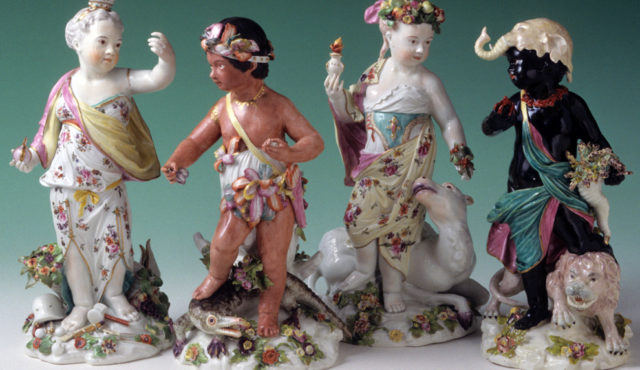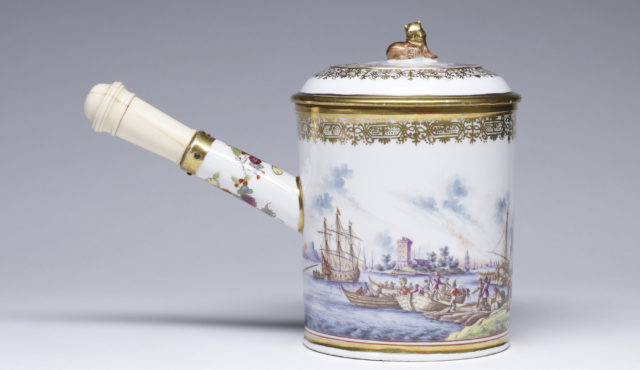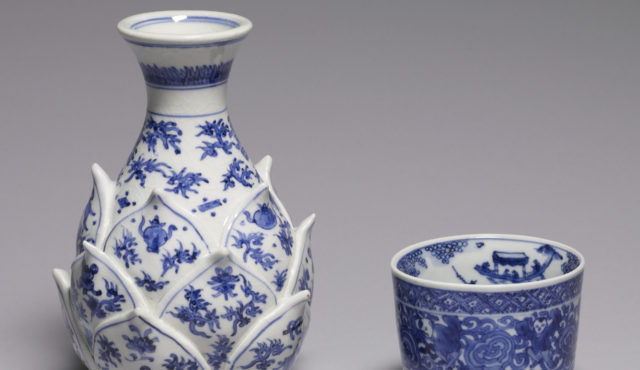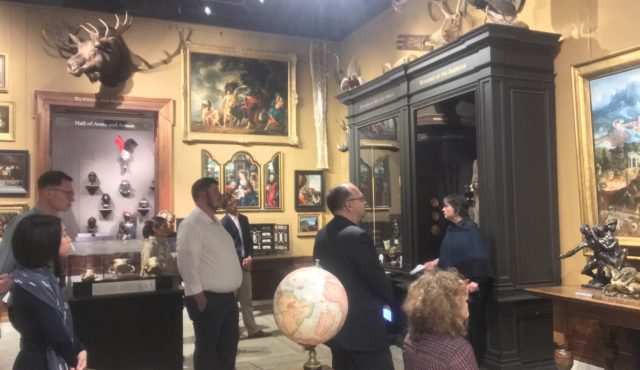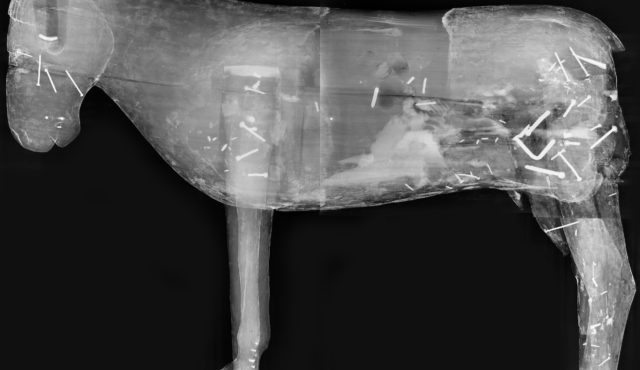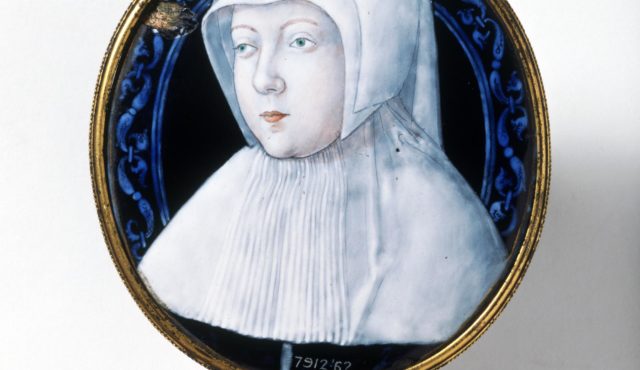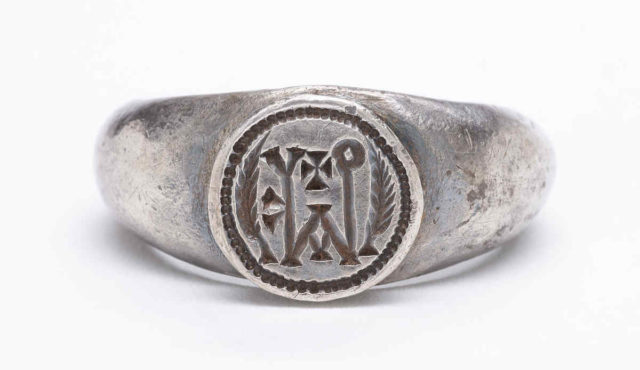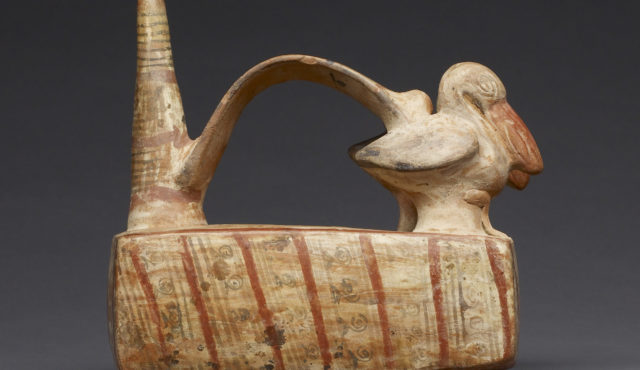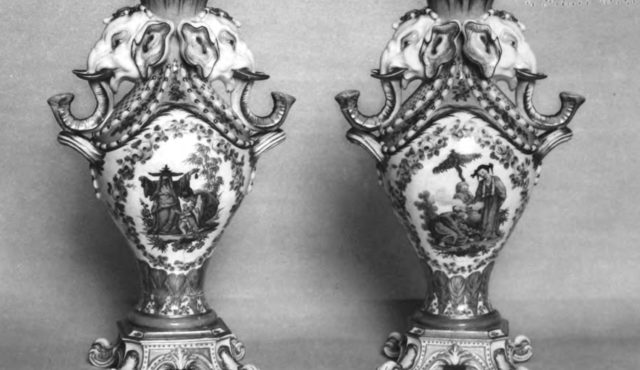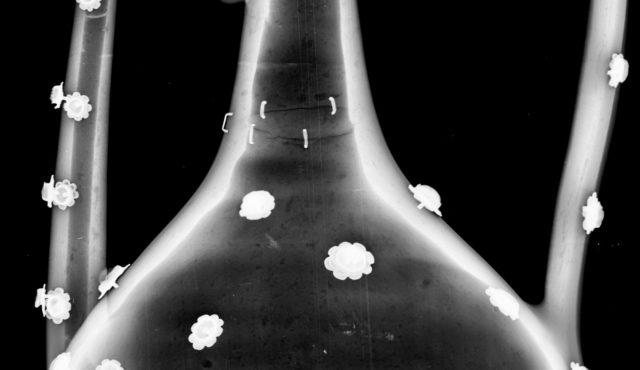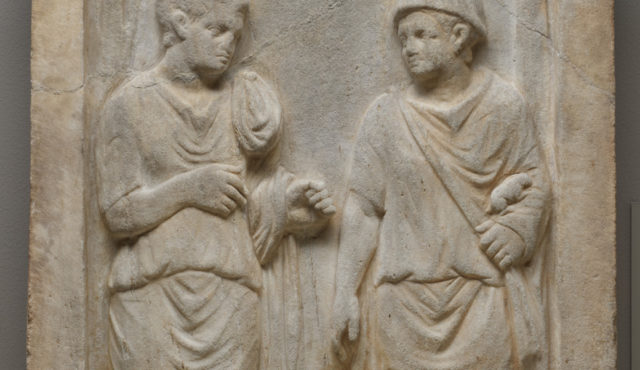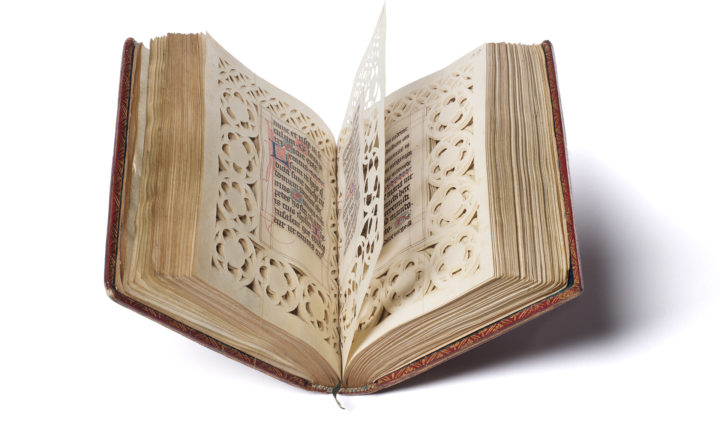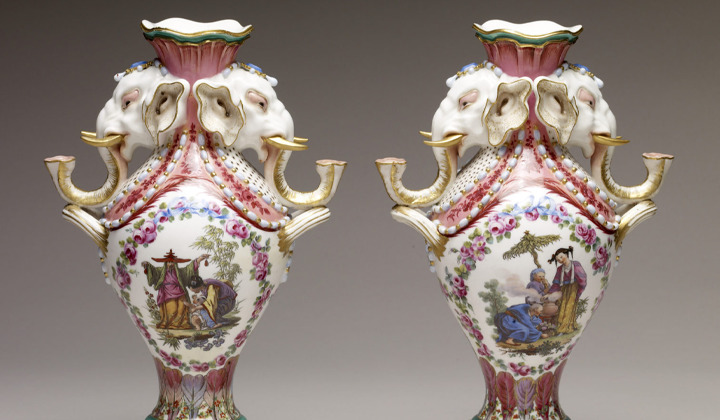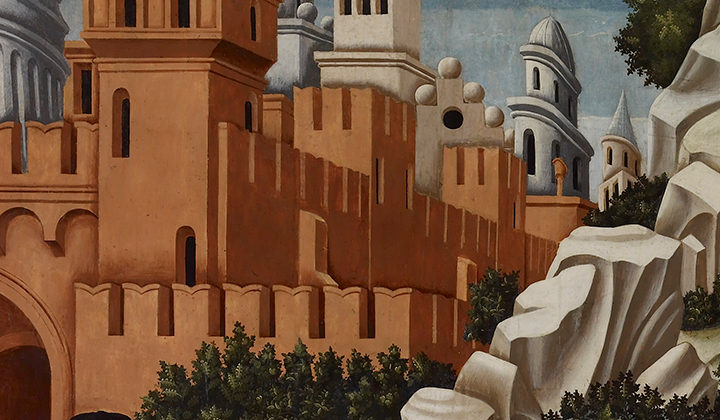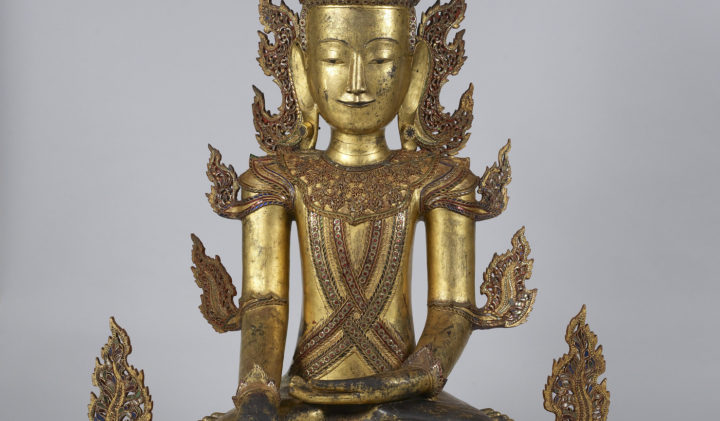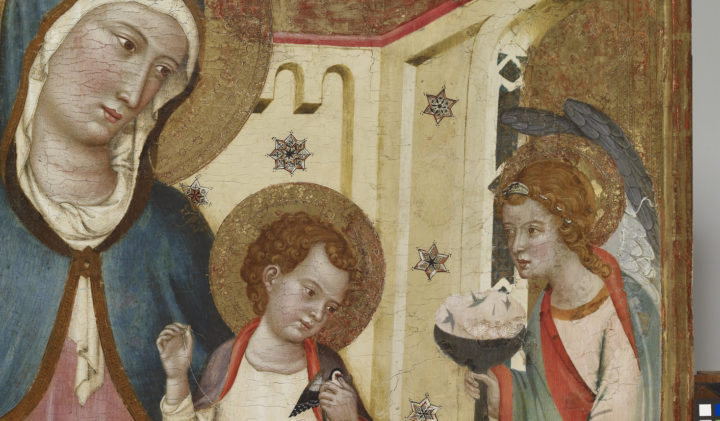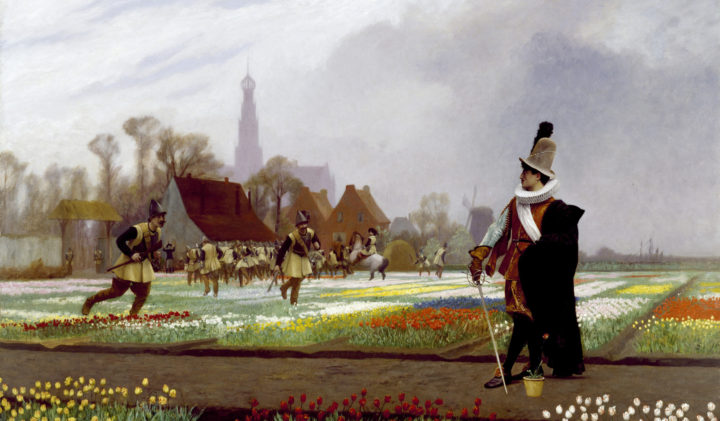In an art museum like the Walters, with collections spanning a broad geographic and chronological range, curators are often charged with protecting, cataloguing, and researching ancient or early modern works whose original primary purpose may not be immediately evident. The default approach to understanding artworks, even three-dimensional ones, is often primarily based on their visual qualities. Yet deeper inquiry into apparently simple objects—like vessels or containers—by means of non-invasive examination techniques, culturally specific research, or working with subject specialists, can allow art museum curators to understand other aspects of these works’ functions. This robust approach offers a more multisensory understanding of works which curators thought they already knew comprehensively. In the case of a ceramic vessel made in ancient Peru, the beautifully patterned designs on its base and attractively molded pelican figures that sit on its edge might distract viewers from its original use: to act as a musical instrument or noisemaker, probably in rituals (fig. 1).
This article examines the historical and geographic context in which this vessel was made, its iconography and imagery, how it was originally used, and then turns to a discussion of how a collaborative partnership between Ellen Hoobler, William B. Ziff, Jr., Associate Curator of Art of the Americas, and intern Sonia Matheus (a student at the Peabody Conservatory of Johns Hopkins University during the 2018–19 academic year) led to a completely new understanding of a whistling vessel at the Walters Art Museum.
The Sicán (or Lambayeque) Culture of Peru and its Musical Instruments
While it does not enjoy the popular renown of the later Inca civilization, the Sicán, or Lambayeque, culture flourished for six centuries in northern Peru (ca. 750–1375 CE). Its study is vastly complicated by the fact that there is no evidence of the Sicán having written records. Much of what we know about these people comes from archaeological investigation and the remains of material culture that have survived. The name Sicán refers to a site (today also called Batán Grande) which was likely the civilization’s capital; in Muchik, an indigenous language of northern Peru, the term means “house or temple of the moon.”[1] However, Sicán is one of many archaeological sites in the northern Peruvian region of Lambayeque, a name which has also been applied to this culture. In this note, the authors use the term Sicán, unless discussing the broader region (fig. 2).[2]
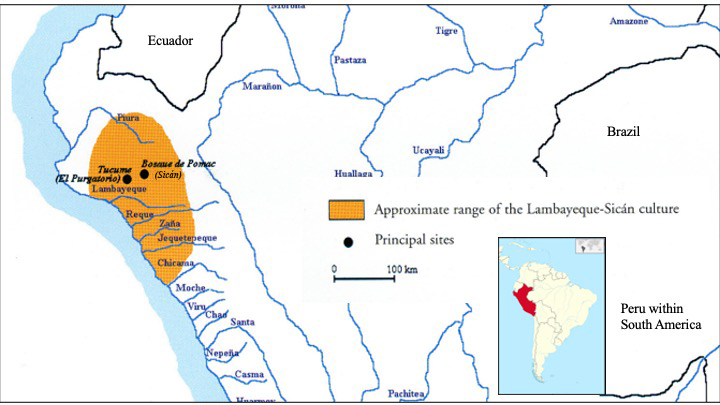
Map, showing the approximate location of the Sicán culture within modern-day Peru, with major Sicán sites indicated.
The Sicán culture was centered on various fertile river valleys that run toward the Pacific Coast in northern Peru. This area was previously dominated by the Moche culture (ca. 100–750 CE) prior to the rapid decline of their civilization, apparently because of drastic ecological changes, occurring about 700 CE.[3] The Sicán were highly influenced by the Moche, who were accomplished ceramic artists and metallurgists. In its early phase of growth, from about 800 CE, the Sicán civilization seems to have been confined to a few northern coastal sites. As the civilization grew, the Sicán occupied more sites, and examples of their ceramics and metalwork became more prevalent across the region during the era archaeologists refer to as the Middle Sicán period (900–1100 CE). Finally, the Late Sicán period marked the end of this civilization, which was ultimately conquered by the Chimú civilization around 1375.
By the culture’s apogee, in the Middle Sicán period, there was a clear hierarchy of political and religious elites. This social ranking can be discerned based on the contents of tombs in the region. During this period, shaft tombs were constructed for prominent people among the Sicán which were filled with objects that suggest the concurrent development of a state religion: works of art and paraphernalia incorporating deities and symbols found across the region. These objects were often made of luxury materials from afar, demonstrating the existence and expansion of trade networks across the Andes and into the Amazon. Through these connections, Sicán elites obtained the Spondylus princeps shells, emeralds, gold, silver, and other precious materials for status goods and grave offerings.[4]
During the Middle Sicán period, craft specialists became highly expert at metallurgy and began to produce, and apparently export, large quantities of prestige ceramics. Probably the most characteristic pottery type of the Sicán is a highly burnished, shiny black ceramic. These ceramics were often decorated with molded or incised imagery of a supernatural being, the Sicán deity, which is shown repeatedly in imagery on Sicán prestige goods. However, there is a second type of ceramic so common to the region that its presence is diagnostic of being within the culture’s sphere of interaction. These are ceramic objects known as tri-color jars. They may be comprised of a single ceramic container, two chambers, or, infrequently, even three vessels interconnected. They usually have a single spout but sometimes have two spouts emerging from the vessel. As the name “tri-color jars” suggests, they are decorated in a limited palette of colors.[5]
The Walters tri-color jar has a single-chamber, and it is what is known as a spout-and bridge-vessel, with a single spout and a curved, thin bridgelike handle spanning the base of the spout to another point on the vessel. In the case of the Walters container, the bridge connects to the backs of the two sculpted birds opposite the spout.
While the vessels’ narrow spouts allowed for less evaporation of the contents in the very dry climate of the Andean region, the meaning behind these unusual forms is not clear. The spout-and-bridge construction forms a handle, which would have been useful for their transport once fired—multiples could be tied to cords then perhaps draped across the back of a llama, for example.[6] Many of these vessel forms, and their decoration, may be reminiscent of earlier forms, modified by the Sicán culture.[7]
While spout-and-bridge vessels could have fulfilled the function of holding liquids, they are rather small, and seem poorly suited to transport large quantities of water or other beverages. In fact, their main function does not seem to have been simply to hold and serve but rather to be a ritual noisemaker. Depending on the specific form and desired sounds, these vessels can be “whistled” in several ways: by simply blowing into their spouts, forcing the passage of air through whistles hidden inside; by moving water around the vessels; or by using a combination of breath and flowing liquids inside the vessels, combining high-pitched whistling with a kind of gurgling or bubbling sound.
A higher-pitched sound is produced using breath only; the sound and a diagram of the movement of air through such vessels can be experienced in this video from the Metropolitan Museum of Art. However, as demonstrated in this sound file of a Chimú whistling jar from the Metropolitan Museum of Art, the addition of water adds a softer dimension and a bubbling sound unusual to ears accustomed to the Western chromatic (musical) scale.
Whistling vessels seem to have originated further north, in present-day Ecuador, perhaps very early; there are whistling bottles from the Chorrera culture (ca. 1300–300 BCE) that, like the example at the Walters, include a ceramic “strap” handle and representations of birds. The form was later adopted by artisans in Peru at the close of the first millennium BCE.[8] Indeed, whistling vessels of different forms seem to have been produced by all the different cultures of the ancient Andes.[9]
One frequently asked question about ancient Peruvian ceramics is how they have survived in such good condition over centuries. Often, the answer is because they were deposited in the shaft tombs mentioned previously, or in ritual caches placed underground. Tri-colored vessels specifically have been found in Middle Sicán burial chambers.[10] While one might assume that funeral ceremonies would be solemn and quiet, archaeologists have shown that postmortem commemoration of Middle Sicán elites were occasions which would have involved the creation of special paraphernalia and extensive feasting.[11] Quite possibly, musical instruments, including the whistling vessels, added sonic accompaniment to communal festivities for funerals, but also were deposited in tombs at the end of such rituals. Thus, these vessels were important for their musical qualities during celebrations for the living, but the decorations on them endured after their use in rituals, perhaps as images for the deceased in the tomb.
While Sicán whistling vessels have not been as extensively researched as musical instruments from other eras of Peru’s pre-Columbian past, excavations in sites related to the earlier Moche culture have shown how incredibly prevalent such noisemakers were. For example, excavations at Huaca de la Luna have recovered over 3,000 fragments of ceramic musical instruments across the archaeological site, of which simple whistles make up some fifty percent of these remains.[12] Like the single-chambered whistle in the Walters collection, these produced fairly high-pitched sounds and did not allow for a great deal of tonal changes. Despite their sonic limitations, they seem to have been used frequently in the Moche culture (and probably in the Sicán world as well).
Appearance and Iconography
The Walters example is similar, although not identical, to other known Sicán vessels in museum collections worldwide. The spout features closely spaced thin black horizontal painted lines, punctuated by thicker red lines at intervals. The handle is similarly painted with thicker red lines alternating with about five thinner black lines, ending in two mold-made figures of waterbirds whose rounded beaks suggest they are pelicans. Its single rectangular chamber is decorated with red and black motifs on a tan background. The body has the same thick red lines, this time arrayed roughly vertically along the sides, interspersed with thin black lines and black spirals. The spiral motifs might represent water, especially because the sculpted decoration of Sicán vessels so frequently shows themes related to water, such as boats, fish, and waterbirds. The most closely comparable object to the example at the Walters is a double-chambered vessel, with similar spirals and red-and-black decoration, from the Museo Larco in Lima, Peru (acc. no. ML XXC-139). However, rather than birds, the top of the vessel shows a personage, presumably a lord, carried in a litter by four attendants. As all the figures apparently are standing on the “water,” there is some question as to whether the identification of the spirals as liquid is correct.[13] Another stylistic parallel is a vessel also in the Museo Larco (acc. no. ML 020330).[14] This is a single-chambered rounded vessel with two spouts (one is now broken). The sides are decorated with two pelicans that are similar enough to those on the Walters vessel that they could have been made from the same mold (fig. 3).
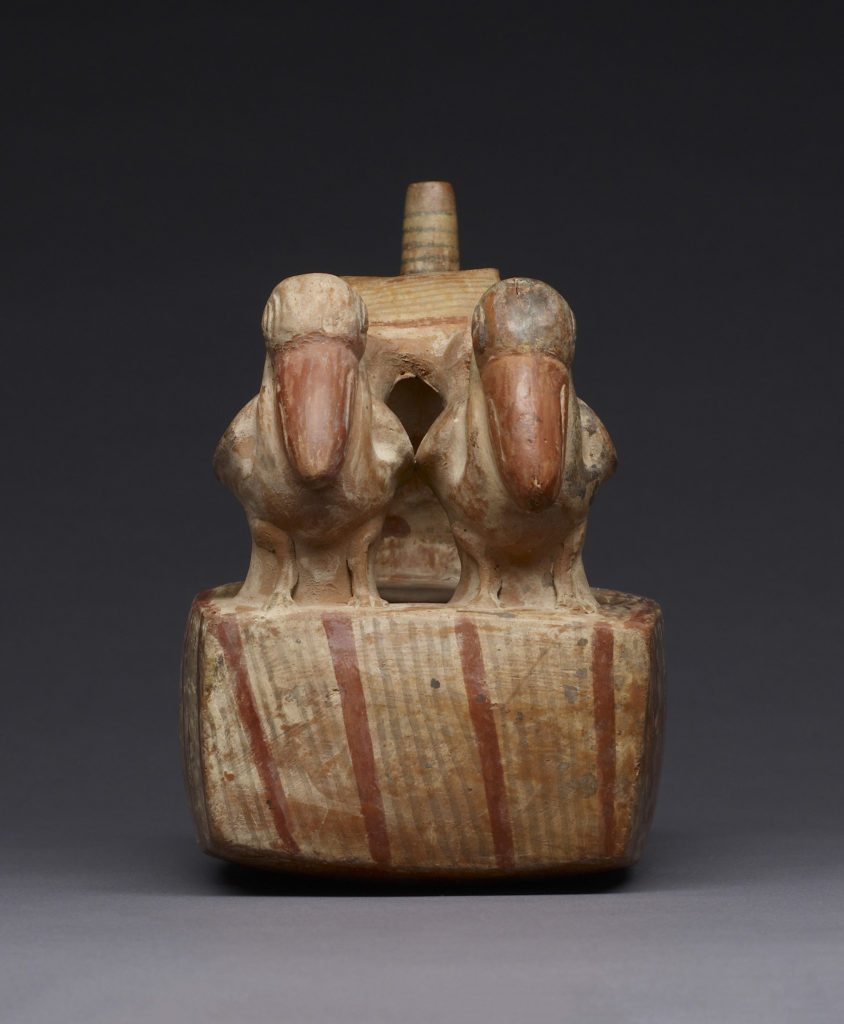
Closeup of molded pelicans on the front of fig. 1.
Many other Sicán whistling vessels often incorporate modeled animals that are carefully and sensitively rendered, including llamas and humans.[15] Some show specific types of people, such as fruit harvesters or sellers, and several show mariners seated in boats that look like those made from totora reeds, watercraft used in Peru into the twentieth century (for example, Fowler Museum, Los Angeles, acc. no. X88.822; Metropolitan Museum of Art, New York, acc. no. 1978.412.4; and the British Museum’s blackware, acc. no. Am1855, 1220.18). And at least one other Sicán vessel incorporates a pelican riding in a totora-reed vessel.[16] In the Fowler and Metropolitan examples, a musical function is alluded to, since the figures in the boats hold panpipes to their mouths.
The two pelicans on the Walters vessels are decorated in a tri-color scheme. Both their beaks are red, and one pelican is executed roughly in black, while the other appears lighter in color. Conservation work has revealed that the proper right bird has been restored, so it is unclear whether a duality in color was intended. As birds are shown on a large proportion of whistling vessels, and one of their most salient characteristics is their song, scholars have frequently speculated that the animals depicted on these vessels were the inspiration for the noises that they could make.
There is extensive lore and ethnographic writing regarding birds in the Andes. Peruvian pelicans (Pelecanus thagus), larger than other pelicans in the region, with wingspans reaching two meters in width, were seen as voracious predators. The colonial-era chronicler Garcilaso de la Vega (1539–1616) noted the pelicans’ particular form of hunting: “It is a thing of much pleasure to see how they fish…many of them [pelicans] come together like two tall towers and from there, like trained falcons, with their wings closed, they let themselves fall to hunt the fish and they dive, entering under the water, such that they seem to have drowned…[and] they can be seen with the fish caught in their mouth, and flying in the air they wolf it down.”[17] Therefore, the representations of pelicans may be a reference to the abundance of the seas, and pelicans’ ability to signal the places where humans might most profitably fish.
However, it is more likely that the birds’ ritual significance for ancient Peruvians was due to their ability to cross various realms, moving between sea and air. Art historian Juliet Wiersema has proposed this hypothesis as a unifying factor among the myriad forms of whistling vessels created by the Moche, at an earlier period in the same northern coast region. Among Moche whistling vessels, Wiersema explains how it “is difficult to find commonalities that unite these disparate sculpted forms,” but “all vessels with whistling mechanisms depict creatures with the ability to enter realms inaccessible to most humans.”[18] Another scholar, Colin McEwan, argues in effect that these vessels were important ritual paraphernalia, probably used in ceremonies: “the purpose of successfully fabricating the hidden whistle seems to have been to create a particular effect—to mysteriously animate the figure which conceals it.”[19]
McEwan also points to ethnographic examples to bolster his argument that these types of vessels were used for rituals, rather than to create music that was primarily for enjoyment or soothing. He notes that in modern-day Bolivia, different types of flutes are played at agriculturally important times of the year, to encourage rain to fall and plants to grow. According to McEwan, “high-pitched wailing sounds are particularly associated with critical moments that mark the transition between the dry and rainy seasons in the Andes and they are especially associated with the dead, who, as a ‘collective’ presence, are said to help the crops grow through the rainy season.”[20]
The high-pitched quality of the vessel may have been part of the vessel’s appeal for the people of Sicán. As mentioned above, Wiersema’s hypothesis was that these types of vessels might imitate the call of the animal depicted, in this case a Peruvian pelican. However, for this species, only baby pelicans can vocalize, making a sound described as “a shrill, rasping squawk to beg for food,” not a likely sound the whistling vessel is emulating.[21]
If not imitating the call of a specific bird or animal, other hypotheses for the high-pitched sound of these Peruvian whistling vessels have been proposed. Scholars Steven Garrett and Daniel K. Stat began to investigate these kinds of vessels in the 1970s, and were pioneers in confirming that many more vessels were sound-producing than had previously been realized. By the 1980s, they suggested these artifacts were made to be played in tandem or in groups. In an interview, Garrett claimed that when two or three whistling vessels were blown simultaneously, the high-pitched sounds they produced would combine to create lower-toned notes that could not be captured by sound recording devices. He said that “these low-frequency sounds were important in religious rituals for changing states of consciousness.”[22] Others concur with this theory—Jorge Pérez de Arce has extensively studied what he calls the “psycho-acoustical” qualities of the vessels. He has noted that the high-pitched noises are similar to those of whistles that modern-day shamans of the Amazon region use in ayahuasca rituals to contact spirits.[23] While such hypotheses are difficult to test, the Walters is one of many art museums interested in presenting the wider range of capabilities of the objects they house. During the exhibition Transformation: Art of the Americas held at the Walters in 2018–19, visitors were able to use a sound system to hear the sounds made by three whistles of the ancient Americas.
Frequently art historians consider these vessels strictly from a visual standpoint, unaware, or ignorant of, the sonic qualities of these objects. Regarding Maya whistles and ocarinas, Jared Katz, currently Assistant Professor of Non-Western Art History at the Rocky Mountain College of Art and Design, and Visiting Curator for Art of the Americas at the Boca Raton Museum of Art, notes that “many scholars have analyzed the instruments’ significance as figurines or ceramic pieces, but not specifically as musical artifacts…they are not only difficult to access geographically; but once in the lab, it also takes time to locate the instruments within the collection.”[24] Most curators are not music specialists, so harnessing additional expertise in other areas can yield new insights.
During the academic year 2018–19, in training as a professional oboist at the prestigious Peabody Conservatory of Music, Sonia Matheus interned with Ellen Hoobler, William B. Ziff, Jr., Associate Curator of Art of the Americas at the Walters. Through her internship, Matheus was able to closely examine a number of musical instruments in the ancient Americas collection. Even basing her findings on a visual analysis alone, Matheus was able to provide significant insights into their sonic qualities. Until this time, there had been little examination of works in the ancient Americas collection with an emphasis on their non-visual properties.
Sound recording of WAM 48.2826 as played by Angela Elliott
Prior to working with Matheus, Hoobler had exhibited the whistling vessel in a small installation comparing geometric decoration on ancient American and ancient Classical ceramics. While preparing the work for this exhibition, Angela Elliott, Terry Drayman-Weisser Head of Objects Conservation and William B. Ziff, Jr Conservator of Objects, came across references to the sonic qualities of these kinds of ceramics. Curious, she tested blowing into the Walters vessel using a pipette, and recorded herself playing a single note on the vessel (fig. 4).
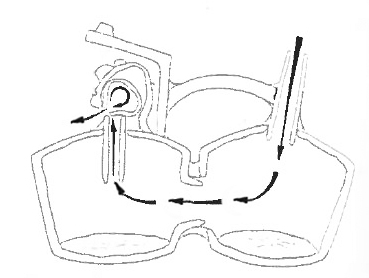
Diagram of a double-chambered whistling vessel.
Thus, although the vessel has some cracking and has been restored, Elliott confirmed that it could still produce sound. (From a conservation standpoint, it is best to keep experiments in playing the vessel to a minimum, as moisture from breath will accrue inside the vessel and could damage it over time.) Upon hearing the vessel played, along with careful visual analysis, Matheus was able to quickly draw conclusions about the sound-producing aspects of the vessel, to a degree that was astounding to (non-musical) Hoobler. [25] Matheus demonstrated that the sound was channeled through the vessel, then emitted from very small holes behind the necks of the pelicans (fig. 5). The backs of the birds’ heads protrude in such a way that the holes are perpendicular to two small globular forms with single holes that are integrated into the flat strap handle of the vessel. The airflow perpendicular to the handle’s holes would produce a clear, high-pitched sound, much like the sound produced when one blows across the top of a glass bottle (fig. 6).[26]
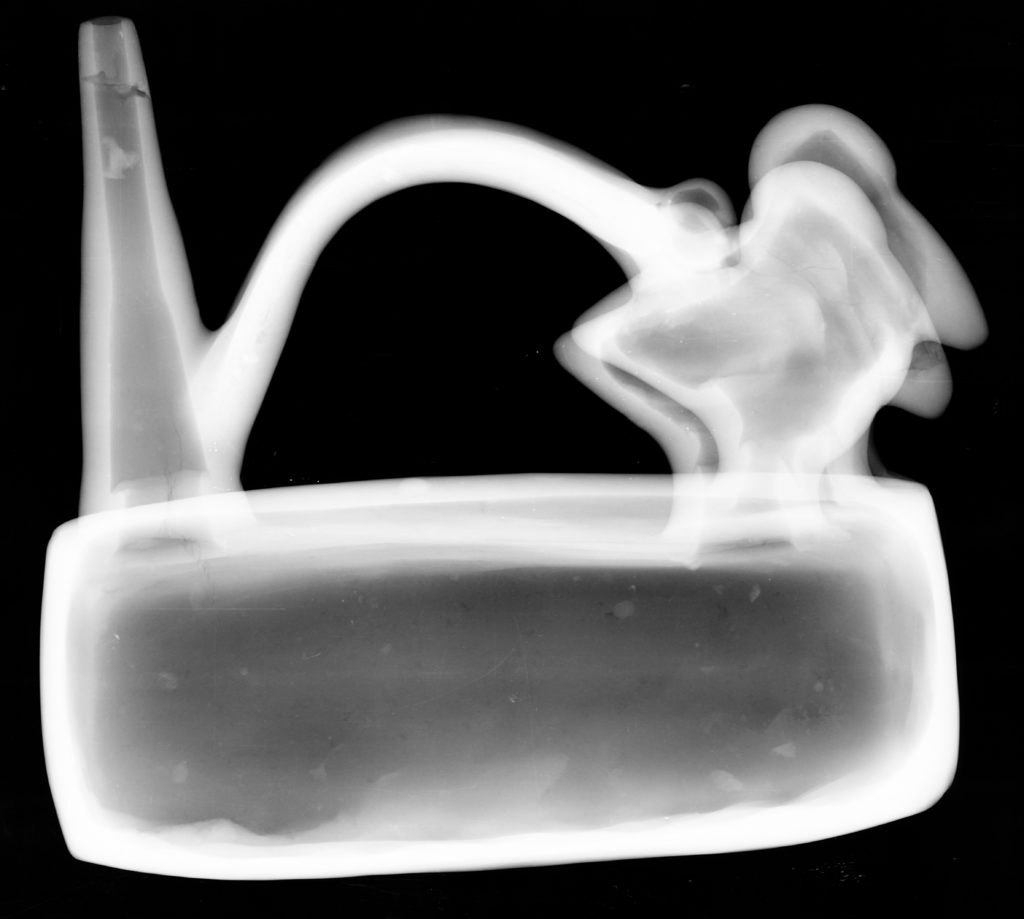
Computed X-ray radiography was performed with a Varian X-ray tube with a Polaris MC-250 control system, GE CR50P plate scanner, and Rhythm software. X-ray radiographs were edited in Adobe Photoshop and with Lucis Pro.
Prior to hearing it played, Matheus had concluded that the sound produced by the vessel would be high-pitched, because the small airway produces greater air pressure and thus, a higher-pitched sound. While the bodies of some other whistling vessels have multiple holes, potentially allowing for different tones, the Walters vessel could produce only a single high-pitched tone (although Matheus also noted some differences in tone could be achieved by partially filling the vessel with water and moving the water as the user blew into the vessel). However, this experiment could not be undertaken for conservation reasons—liquid could potentially dissolve residues from its use or disturb unstable original surfaces.
Although unaware of Garrett and Stat’s research, Matheus agreed that since this particular instrument, based on its dimensions, could only produce a single pitch (or two, depending on whether it was filled with water), it is probable that other vessels of different shapes and sizes were meant to be played in unison with it, to create a more complex blending of pitches. She hypothesized that this vessel may have been played alongside multiple vessels in a ceremony, in which many noisemakers whistled together to create a harmonious melody or song.[27] Matheus also raised some very interesting, as yet unanswered, questions regarding the context in which this vessel was used. The sound it produced was piercing, yet not overwhelmingly loud, leading her to question what kinds of acoustic environments would have best highlighted the vessel’s strengths. Small, enclosed spaces, such as tombs? Larger plazas? On the coastline, calling to pelicans? This one example shows how the kinds of questions someone trained in auditory performance asks of objects like this are immensely productive, and quite different from the inquiries that mostly visually oriented curators might ask.
In general, this collaborative research highlighted a number of different themes. On the most basic and practical level, it shows how even as art curators today strive to understand the works in their care in the multisensory ways they originally functioned (and therefore create richer, multilayered experiences with them), most curators still very much work by default in an environment with a “‘sense hierarchy’ that elevates and privileges sight above other senses.”[28] As Jared Katz and other scholars have recommended, curators who work with pre-Columbian objects should first identify the works in their collection that had a noise-making component to their use. There is still much to be gained from physical study of works in museums, particularly in multidisciplinary groups perhaps including conservators, ceramic specialists, and musicians. Second, curators should continue to experiment with recording sounds from original artifacts as long as they do not compromise the works’ safety. This would permit the creation of a database of such sounds, and increase our understanding of how multiple instruments could perhaps have been played together. Third, we should encourage the creation of replicas to further explore the sonic qualities of these vessels without concern for the safety of the originals. Replicas could be safely filled with water, and the subject of further experimentation (since, in cases where there are no representations of how such works were played, other options for producing additional sounds, or combining multiple sounds, may become obvious). With the aid of non-destructive techniques such as CT scanning or X-radiography, we can determine the thickness of vessel walls and forms to create accurate replicas. Katz has created 3D-printed replicas of Maya whistles and ocarinas, and an accompanying database. The Walters has commissioned two replicas of whistling vessels, including this one, be made by local ceramicist and ancient American musical specialist Melissa Foss. Documenting experimentation with replicas would allow visitors a different experience of the museum space, something the Walters has already promoted in its popular Art Sound Now program, where live musicians perform melodies related to the art on view in selected galleries.
Given the proximity of the Peabody Conservatory to the Walters Art Museum, and the frequent lack of musical experience and knowledge on the part of curators, collaboration with music specialists would be both easy and essential to finding plausible ways of playing these replicas. This collaboration between Hoobler and Matheus, curator and musician, illustrated how specialists need not have an extensive background in the ancient Americas to be able to offer alternative understandings of such objects which can contribute to our knowledge of its material culture in an invaluable way.
Special thanks to Angie Elliott and Melissa Foss for their input and comments, that greatly enriched this essay.
[1] Izumi Shimada,“Who Were the Sicán? Their Development, Characteristics and Legacies,” English translation of the introductory essay to The Golden Capital of Sicán [in Japanese], eds. Izumi Shimada, Ken-Ichi Shinoda, Masahiro Ono (Tokyo: Tokyo Broadcasting System, 2009), 2.
[2] An excellent introduction to (fairly) recent research into the Sicán can be found in the English translation of Izumi Shimada’s essay “Who Were the Sicán? Their Development, Characteristics and Legacies.” Shimada, the pre-eminent archaeologist who has excavated in Sicán territory, prefers the term “Sicán.”
[3] Shimada, 5–6.
[4] See Shimada, “Who Were the Sicán?”; see also Shimada et al., “An Integrated Analysis of Pre-Hispanic Mortuary Practices: A Middle Sicán Case Study,” Current Anthropology 45, no. 3 (June 2004): 369–402.
[5] Shimada, “Horizontal and Vertical Dimensions of Prehistoric States in North Peru,” in The Origins and Development of the Andean State, eds. Jonathan Haas and Shelia Pozorski (Cambridge: Cambridge University Press, 1987, 141. Shimada, “Who Were the Sicán?,” 31. In the former, Shimada refers to these as “tri-color jars,” in an elite tomb, whereas the latter suggests that single- and double-spouted jars, decoration unspecified, were found even in the graves of commoners.
[6] An earlier Moche stirrup spout vessel at the Art Institute of Chicago (acc. no. 1955.2302) seems to show a llama with connected vessels across its back, although apparently in bags. [https://www.artic.edu/artworks/91584/stirrup-spout-vessel-in-form-of-a-pack-llama]
[7] These vessels are very similar to forms and decoration of vessels from the Virú (Gallinazo) culture of Peru’s north coast (200 BCE–200 CE). However, Sicán vessels exchange a ropelike, coil strap for the thinner, ribbonlike strap, and while decorations on Virú vessels are executed only in resist technique, the Sicán ceramics include both resist and slip decoration. Therefore, the decoration of Virú ceramics is in two colors, while Sicán pottery often is adorned in three colors. See, for example, comparative examples in Kathleen Berrin, ed., The Spirit of Ancient Peru: Treasures from the Museo Arqueológico Rafael Larco Herrera (San Francisco: Fine Arts Museums of San Francisco, 1997).
[8] A helpful summary of the evidence of early vessels is included in Mónica de Luca Polanco, Mónica Ayala Esparza, and Tomás Espinosa, “Botellas silbato, sonidos ocultos en el tiempo,” Axioma 14, vol. 1 (2015): 64. On adoption of the form in Peru, see Colin McEwan, “Whistling Vessels from Pre-Hispanic Peru,” in Pottery in the Making: Ceramic Traditions, eds. Ian Freestone and David Gaimster (Washington, DC: Smithsonian Institution, 1997), 176–81 at 176.
[9] Steven Garrett and Daniel K. Stat, “Peruvian Whistling Bottles,” Journal of the Acoustical Society of America 62 (1977): 449–53. Garrett and Stat documented whistling vessels among nine different groups from ancient Peru.
[10] One burial chamber at Huaca Las Ventanas excavated in 1981 was described as containing both blackware and tri-color ceramics. See Shimada, “Horizontal and Vertical Dimensions,” 141.
[11] On these activities, see Go Matsumoto, “Eating and Drinking with the Dead: Commensal Hospitality for Integrating People in the Multiethnic Society during the Middle Sicán Period (ca. 950–1100)” (Paper presented at the 78th Annual Meeting of the Society for American Archaeology, April 2013).
[12] Dianne Scullin and Brian Boyd, “Whistles in the wind: The Noisy Moche City,” World Archaeology 46 no. 3 (2014): 362–79 at 369, https://doi.org/10.1080/00438243.2014.921099.
[13] See Museo Larco, acc. no. XXC-000-139, illustrated in Berrin, Spirit of Ancient Peru, 181. Another single-chambered vessel with spirals on its square base and two sculpted birds like the Walters’ is illustrated in José Pérez de Arce, “Whistling Bottles: Sound, Mind and Water,” in Music Archaeology in Context: Archaeological Semantics, Historical Implications, Socio-Cultural Connotations, ed. Draffkorn Kilmer et al. (Rahden/Westf: Marie Leidorf, 2006): 1–22 at 16. It is described as originating from the south-central Peruvian Wari culture, more or less contemporaneous with the Sicán. The much shorter beaks suggest that the birds on this vessel do not represent pelicans, however.
[14] Illustrated in Luis Alfredo Narváez Vargas, Dioses de Lambayeque: Introducción al estudio de la mitología tardía de la costa norte del Perú(Lambayeque, Peru: Ministerio de Cultura del Perú and Museo de Sitio Tucumé, 2014), 284.
[15] Gardiner Museum, Toronto, acc. no. G83 1.172 [http://emuseum.gardinermuseum.on.ca/objects/365/doublechambered-figural-bridgespout-whistling-bottle?ctx=92220e8c-2c68-428b-ba4e-a638cbebafd4&idx=11]. Other animals are sometimes shown, for example, a Sicán vessel in the Florida Museum of Natural History incorporates two other molded birds, whose head plumage is rendered carefully enough to securely identify them as curassows. See plate 3 of “Andean Artifacts,” Florida Museum of Natural History, University of Florida, updated October 8, 2018, https://www.floridamuseum.ufl.edu/latinarch/catalog/andean-artifacts/.
[16] Illustrated in Garrett and Stat, “Peruvian Whistling Bottles,” 450, fig. 3a.
[17] Translation by Ellen Hoobler. Garcilaso de la Vega, Historia General del Peru/Comentarios Reales, Vol. II [1617], 92, as cited in Andrés Gutiérrez Usillos, Dioses, símbolos y alimentacion en los Andes: Interrelación Hombre-Fauna en el Ecuador prehispánico (Quito, Ecuador: Ediciones Abya-Yala, 2002), 314. According to Wikipedia, the larger Peruvian pelican may not dive from as great a height to fish as the brown pelican, but the sight of such a large bird diving would still have been impressive. “Peruvian pelican, ” Wikipedia, last modified April 13, 2021, https://en.wikipedia.org/wiki/Peruvian_pelican.
[18] Juliet B. Wiersema, Architectural Vessels of the Moche: Ceramic Diagrams of Sacred Space in Ancient Peru (Austin: University of Texas Press, 2015), 119.
[19] McEwan, “Whistling Vessels,” 180.
[20] McEwan, 180. Other scholars have noted that what might seem to be simply noise, even unpleasant to Western ears, could have satisfied ritual or aural needs for ancient Peruvians. See Scullin and Boyd, “Noisy Moche City,” 364–66.
[21] “Brown pelican sounds,” All About Birds, accessed March 31, 2020, https://www.allaboutbirds.org/guide/Brown_Pelican/sounds. Adult pelicans can make hoarse grunting sounds by moving their wings in such a way as to force air from their lungs, and they can snap their bills together with a loud popping sound. (A bill snap, grunt, and hiss sound made by a Peruvian pelican can be heard here: https://www.xeno-canto.org/species/Pelecanus-thagus.)
[22] Garrett, quoted in William J. Broad, “Complex Whistles Found to Play Key Roles in Inca and Maya Life,” New York Times, March 29, 1988, sec. C.
[23] Pérez de Arce, “Whistling Bottles,” 6.
[24] Jared Katz, “The Maya Music Project: Analysis and documentation of Ancient Maya Musical Artifacts” in Papers for the 9th Symposium of the International Study Group on Music Archaeology at the Ethnological Museum, State Museums Berlin, 09-12 September, 2014, ed. Ricardo Eichmann et al. (Rahden/Westf.: Verlag Marie Leidorf, 2016), 257–61 at 257.
[25] While there are some specialists in the music of the ancient Americas—Pérez de Arce, Katz, Adje Both, and others—it was very eye-opening for Hoobler to see how transferable contemporary musical knowledge was to comprehending instruments of the ancient Americas for Matheus.
[26] Computed X-ray radiography was performed with a Varian X-ray tube with a Polaris MC-250 control system, GE CR50P plate scanner, and Rhythm software. X-ray radiographs were edited in Adobe Photoshop and with Lucis Pro.
[27] As Scullin and Boyd point out, what is “harmonious” or “appropriate” will vary culturally, so that while Andean whistles may have sounded more like “noise” and less like “music” to Western ears, they could still have fulfilled their function well according to Andean ideals. Or, as Garrett and Stat have claimed, two or more of these high-pitched whistles played simultaneously might create the effect of a third, lower-pitched tone.
[28] Nina Levent and Alvaro Pascual-Leone, “Introduction,” in The Multisensory Museum: Cross-Disciplinary Perspectives on Touch, Sound, Smell, Memory, and Space (Lanham, MD: Rowman & Littlefield, 2014), xviii.






